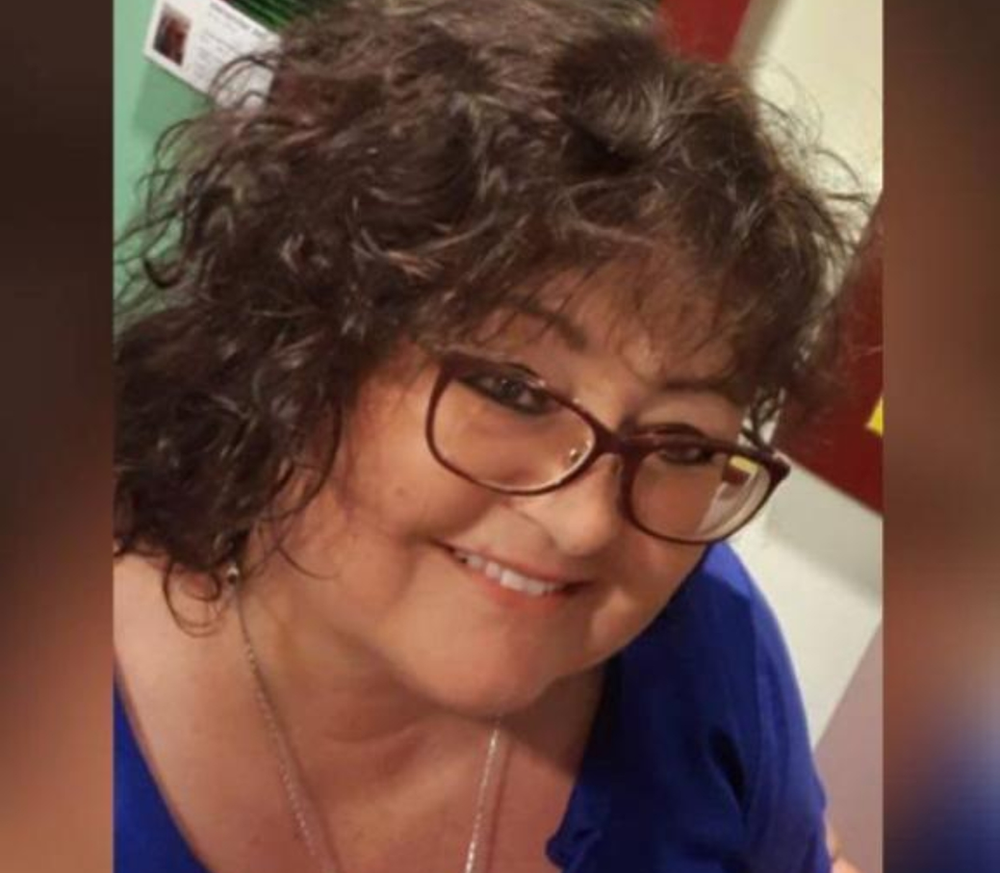
Brigitta Strietezsky
Medico con un’inconsapevole inclinazione naturale verso l’arte, Brigitta Strietezsky scopre la propria indole creativa a seguito di un evento traumatico, una complicata operazione che l’ha costretta a letto per molti mesi; lei, che nella sofferenza umana e nella consapevolezza di quanto l’approccio mentale positivo sia fondamentale per la guarigione e la ripresa aveva vissuto tutte le giornate lavorative prima di quel momento, non si è abbattuta e ha trovato il modo per impegnare il tempo dell’immobilità attraverso una valvola di sfogo che non sapeva di avere, quel mondo creativo che lentamente è entrato a far parte della sua quotidianità. Da dodici anni a questa parte la Strietezsky non si è più fermata, ha liberato un canale espressivo che non è più riuscito a restare in silenzio, ha appreso a domare l’impulsività che inizialmente era un grido, un desiderio di opporsi emotivamente a quanto le era accaduto, e poi lentamente si è affievolito, si è calmato inducendola a narrare le sensazioni percepite in maniera più morbida, intensa ma al tempo stesso serena. Decide di approfondire lo studio della tecnica seguendo corsi con maestri diversi proprio per non perdere un’immediatezza che non voleva fosse domata dalle regole accademiche, e comincia a partecipare a molte mostre collettive nel suo paese, l’Austria, e anche all’estero dove viene apprezzata dal pubblico e dagli addetti ai lavori in virtù della sua capacità di parlare direttamente alle emozioni di chi osserva i suoi dipinti. Dal punto di vista cromatico le sue tele sono palpitanti, esplosive perché narrano quelle sensazioni che non saprebbe esprimere se non attraverso la pittura, perché troppo spesso l’incapacità di comunicare attraverso le parole inducono le singole sensibilità a trattenerle all’interno di se stesse, rinunciando di fatto a guardarle, osservarle, comprenderle e, solo dopo, superarle; tuttavia le tonalità si modificano nel corso del tempo, dall’impetuosa gamma delle prime opere, quelle più impulsive, quelle durante le quali il canale espressivo si era aperto e doveva lasciar fuoriuscire quella cascata emotiva fino a quel momento trattenuta, passa gradualmente a sfumature più polverose, più soffici, più affini a un approccio meditativo, di attento ascolto nei confronti del sentire più profondo ma tuttavia moderate dalla consapevolezza di potersi esprimere senza l’urgenza precedente, senza che la manifestazione pittorica sia ancora un atto di ribellione nei confronti del silenzio interiore. E gioca anche Brigitta Strietezsky, gioca con l’ambiguità dei titoli, così come con la realtà non realtà che dipinge, perché lo stile che sceglie per liberare la sua inclinazione artistica è quell’Espressionismo Astratto versatile e mutevole che può passare dall’irruenza alla calma passando per tutta la gamma di sensazioni che si collocano all’interno dei due estremi. Nella tela Aussenseiter (Fuori dagli schemi)
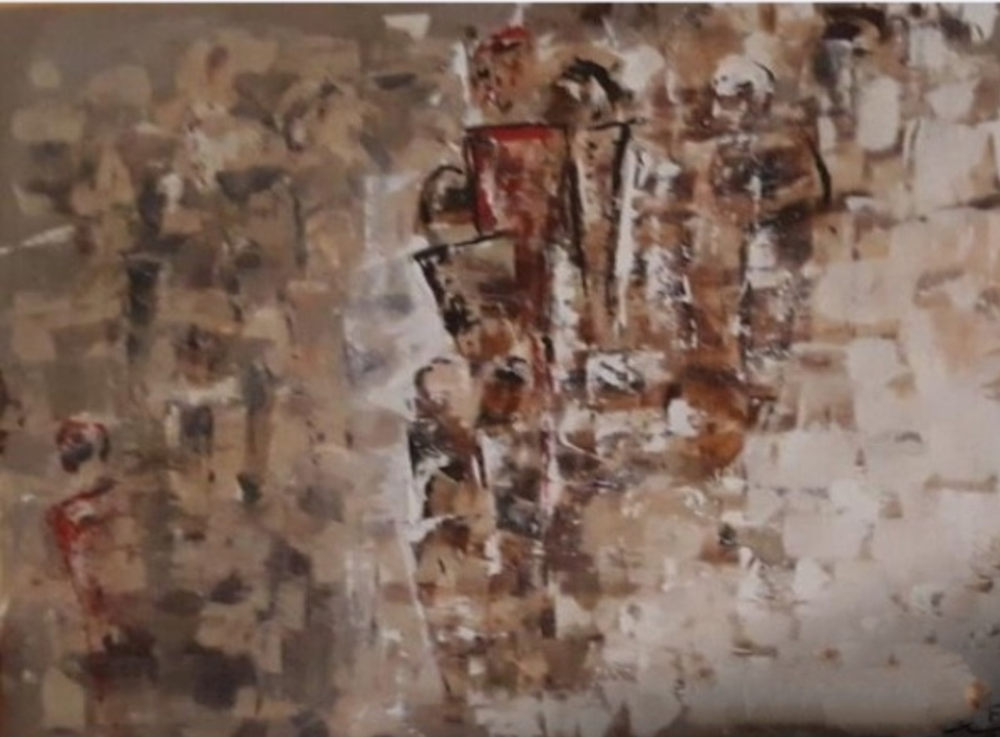
Aussenseiter
l’artista sembra voler suggerire all’osservatore di non adeguarsi alla voce comune, al dato di fatto che spesso appare come l’unica risposta, l’unica scelta possibile, bensì di seguire il proprio cammino, il proprio percorso, sia che rientri nella logica generalizzata sia che non lo faccia, ed è questo l’unico modo di vivere la pienezza dell’esistenza. Così come in Aus-Weg! Ausweg (Fuori dai piedi! Via d’uscita)
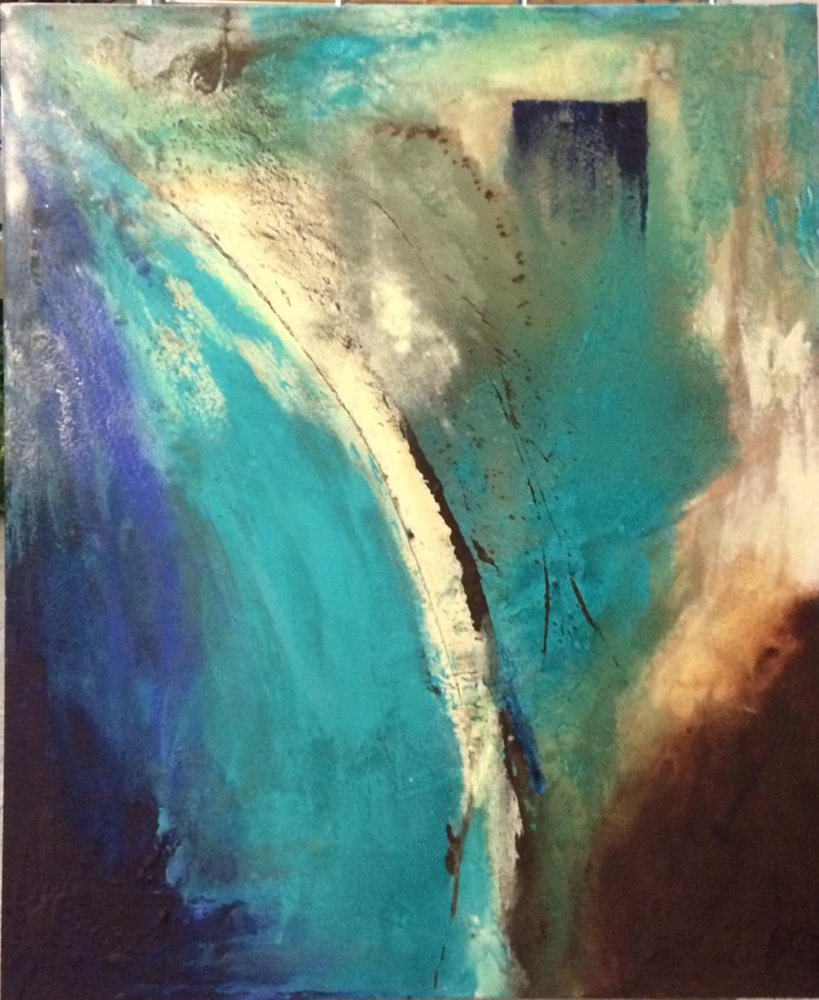
Aus-Weg! Ausweg
descrive la doppia possibilità che si manifesta in ogni azione, in ogni circostanza, perché ciò che sembra negativo in realtà può avere un risvolto molto più positivo di quanto immaginato; sembra quasi introspettiva quest’opera, risultato di una meditazione su quanto le operazioni subite tanti anni fa siano state in grado di modificare e trasformare la realtà intorno a lei e permetterle di entrare nel mondo della creatività. Approfondiamo ora le tematiche e l’intento espressivo direttamente con l’artista.
Brigitta il suo evento traumatico ha generato un inaspettato risvolto nella sua esistenza, ci racconta quali sono state le emozioni che ha provato e qual è stato il momento in cui ha sentito che attraverso l’arte avrebbe potuto trovare una via d’uscita?
In realtà la mia sofferenza è di lunga data poiché ho scoperto di soffrire di tumore osseo dodici anni fa, tuttavia questa bruttissima notizia è stata accompagnata fin da subito dalla rassicurazione che fosse un tipo di cancro curabile e che mi sarei dovuta sottoporre a un complesso e massiccio intervento fisico che inizialmente ha costituito un trauma a malapena comprensibile e che è rimasto dentro di me molto a lungo. Un mio amico mi ha spinta a dipingere, mi ha consigliata di manifestare sulla tela quel senso di rabbia che ho provato quando ho appreso la notizia della mia malattia. È così che sono nate le prime opere rosso intenso, molto colate e solo parzialmente riempite.
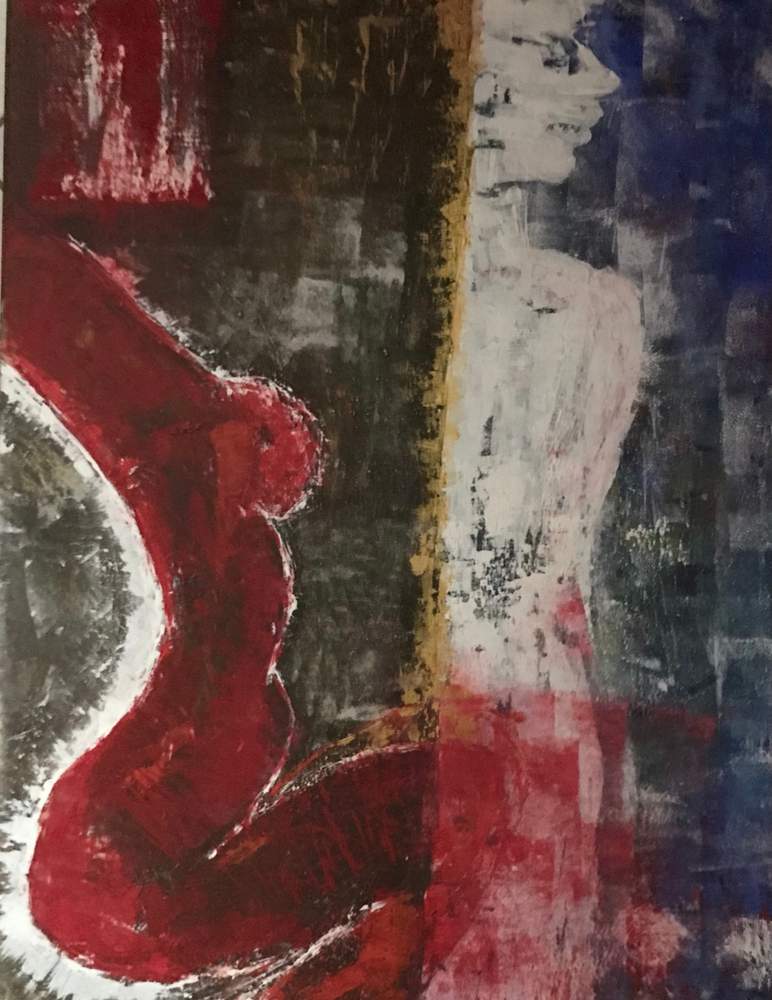
Koplfo(o)s
La sua carriera di medico si è interrotta dopo l’evento che ha cambiato tutto oppure l’arte si è affiancata alla sua professione? Se sì, in che modo riesce a conciliarle?
Ho continuato a esercitare la professione medica e quando lavoravo dedicavo le mie serate a dipingere perché il sollievo che provavo manifestando le mie emozioni sulla tela era indispensabile per il mio equilibrio; ora però sono in pensione da circa quattro anni, quindi ho molto più tempo per dipingere, ho molte più occasioni per riflettere su me stessa e trovare nuove ispirazioni. Soffro costantemente a causa della poliartrite reumatoide eppure, malgrado il dolore a volte difficilmente gestibile, cerco di avere la costanza di dipingere spesso per non permettere alle mie ossa di atrofizzarsi impedendomi di dedicarmi a ciò che ora amo di più.
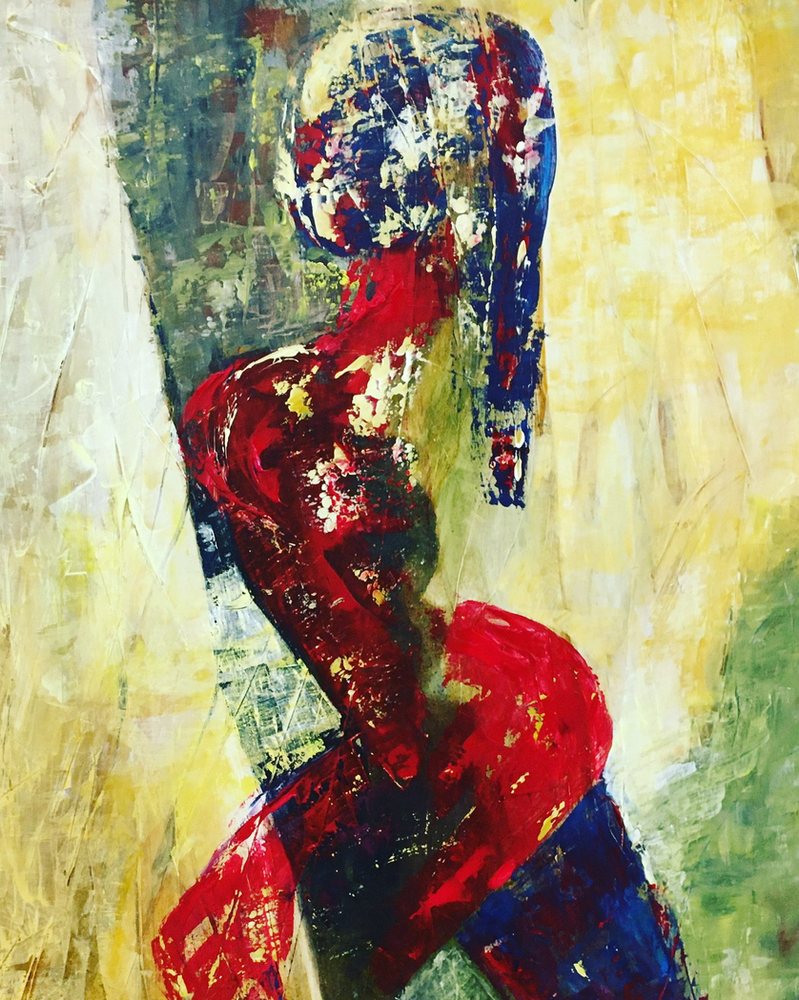
Wow
Nelle sue opere parla di sensazioni intense che possono diventare un suggerimento per affrontare la vita in modo differente rispetto a come si è abituati, qual è il messaggio che vorrebbe giungesse all’osservatore? Quanto c’è di vissuto nelle sue tele e quanto invece è il risultato di un ascolto delle emozioni esterne a lei, quelle che percepisce e ascolta da ciò che le ruota intorno?
Tutte le mie opere parlano delle mie stesse emozioni, la maggior parte raccontano del dolore, che ha accompagnato e accompagna il mio corpo da molti anni, e poi rabbia, aggressività, ma anche gratitudine per essere ancora in grado di camminare e tanta umiltà che credo sia un principio importante dell’essere umano. Nelle mie tele metto sempre al centro il tema dell’amore, della famiglia perché credo che siano gli elementi essenziali della vita di ciascuno, non si può prescindere da questi due ingredienti per essere felici; è questo il messaggio che cerco di trasmettere a chi guarda le mie opere, messaggio che ovviamente appartiene al mio personale punto di vista. La mia pittura è intuitiva, non ho obiettivi prefissati da cui parto, mi siedo davanti alla tela e mi lascio andare alle sensazioni, senza preoccuparmi troppo se a qualcuno piace il quadro, dipingo per me e la mia felicità più grande è che tante persone, tanti collezionisti abbiano apprezzato il mio messaggio e abbiano scelto di avere i miei dipinti nelle loro case.
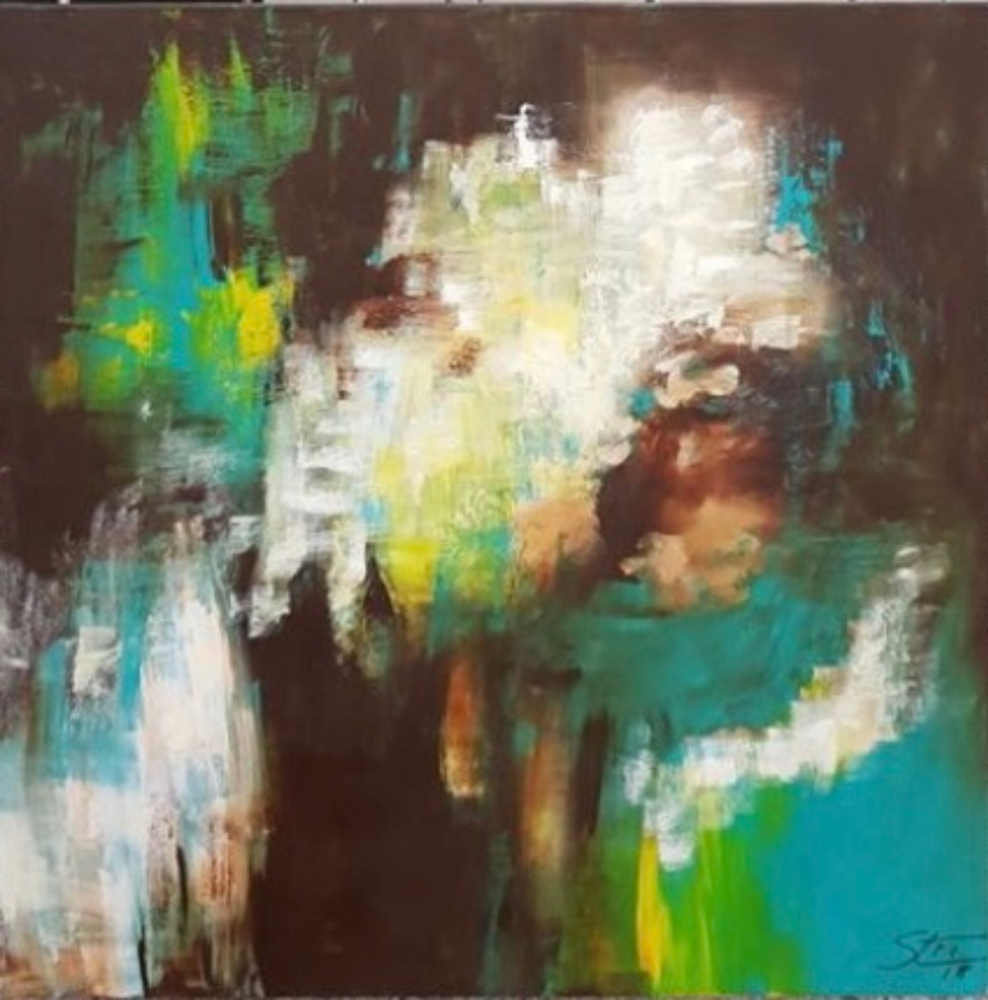
Traumbaum
Ci sono maestri del passato, o del presente, che l’hanno ispirata, a cui si sente vicina per intento espressivo o per capacità comunicativa?
Non mi sono ispirata a qualche artista in particolare perché ho iniziato a dipingere in una fase molto brutta della mia vita, dunque per me l’arte è stata una vera e propria terapia emotiva attraverso cui liberare ciò che avevo dentro. Solo in un secondo momento ho iniziato ad interessarmi a Ernst Fuchs, uno degli artisti che ammiro di più, e anche agli impressionisti. E poi la mia amica Dina Larot, anche lei artista con cinquant’anni di esperienza, che mi dà consigli importanti sulle mie opere.
Quali sono i suoi prossimi progetti? Ha in programma mostre nei prossimi mesi?
Attualmente ho in corso una mostra personale a Linz e sono coinvolta in diverse mostre a Vienna, non ho ancora in mente la programmazione autunnale, ma certamente continuerò a dipingere e a esporre.
BRIGITTA STRITEZSKY-CONTATTI
Email: gitti.stri@gmail.com
Sito web: https://www.brigitta-stritezsky-art.at
Facebook: https://www.facebook.com/profile.php?id=100001477516535
Instagram: https://www.instagram.com/stritezsky_art/
Marta Lock’s interviews:
Brigitta Strietezsky, the events that change everything
A doctor with an unconscious natural inclination towards art, Brigitta Strietezsky discovered her creative nature following a traumatic event, a complicated operation that forced her to stay in bed for many months; she, who had lived all her working days before that moment in the midst of human suffering and in the knowledge that a positive mental approach is fundamental for healing and recovery, did not give up and found a way to use the time of immobility through an outlet she did not know she had, that creative world which slowly became part of her daily life. For twelve years now, Strietezsky has not stopped, she has freed an expressive channel that has no longer been able to remain silent, she has learned to tame the impulsiveness that was initially a cry, a desire to emotionally oppose what had happened to her, and then slowly faded, calmed down leading her to narrate the sensations perceived in a softer, more intense but at the same time serene way. She decided to deepen the study of her technique by following courses with different masters so as not to lose an immediacy that she did not want to be tamed by academic rules, and she began to participate in many collective exhibitions in her country, Austria, and also abroad, where she was appreciated by the public and by the experts because of her ability to speak directly to the emotions of those who observed her paintings. From a chromatic point of view, her canvases are palpitating, explosive because they narrate those sensations that she would not know how to express if not through painting, because all too often the inability to communicate through words induces individual sensibilities to hold them within themselves, effectively renouncing to look at them, observe them, understand them and, only then, overcome them; however, the tonalities change over time, from the impetuous range of the first artworks, the more impulsive ones, those during which the expressive channel had opened and had to let out that emotional cascade which had been held back until that moment, gradually passing to more powdery, softer shades, more akin to a meditative approach, of careful listening to the deepest feelings but nevertheless moderated by the awareness of being able to express oneself without the previous urgency, without the pictorial manifestation still being an act of rebellion against the inner silence. Brigitta Strietezsky also plays with the ambiguity of titles, as well as with the non-reality she paints, because the style she chooses to release her artistic inclination is that versatile and changeable Abstract Expressionism that can go from impetuousness to calmness, passing through the whole range of sensations that lie within the two extremes. In the canvas Aussenseiter (Outside the box) the artist seems to want to suggest to the observer not to conform to the common voice, to the fact that often appears to be the only answer, the only possible choice, but to follow his own path, his own route, whether it fits into the generalised logic or not, and this is the only way to experience the fullness of existence. Just as in Aus-Weg! Ausweg (Out of the way! Way out), she describes the double possibility that manifests itself in every action, in every circumstance, because what seems negative can actually have a much more positive outcome than imagined; this painting seems almost introspective, the result of a meditation on how the operations she underwent many years ago were able to modify and transform the reality around her and allow her to enter the world of creativity. Let us now explore the themes and expressive intent directly with the artist.
Brigitta, your traumatic event has generated an unexpected turn of events in your life. Can you tell us what emotions you felt and what was the moment when you felt you could have found a way out through art?
Actually, my suffering is long-standing, as I discovered I was suffering from bone cancer twelve years ago, but this very bad news was accompanied from the very beginning by the reassurance that it was a curable type of cancer and that I would have to undergo a complex and massive physical operation, which initially constituted a barely comprehensible trauma that stayed with me for a very long time. A friend of mine urged me to paint, advised me to express on canvas the sense of anger I felt when I heard the news of my illness. That’s how the first deep red works were born, very poured and only partially filled.
Did your career as a doctor come to a halt after the event that changed everything, or did art become part of your profession? If so, how do you reconcile them?
I continued to practise medicine, and when I was working I used to spend my evenings painting because the relief I felt when I expressed my emotions on canvas was essential for my balance; but now I have been retired for about four years, so I have much more time to paint, I have many more opportunities to reflect on myself and find new inspiration. I am constantly suffering from rheumatoid polyarthritis and yet, despite the pain which is sometimes difficult to manage, I try to have the constancy to paint often so that my bones do not atrophy and prevent me from stop devoting myself to what I now love most.
In your paintings you talk about intense feelings that can become a suggestion for approaching life in a different way than we are used to, what is the message you would like to convey to the viewer? How much is lived experience in your canvases and how much is the result of listening to emotions outside of you, those that you perceive and hear from the world around you?
All my artworks speak of my own emotions, most of them tell of pain, which has accompanied and accompanies my body since from many years, and then anger, aggression, but also gratitude for still being able to walk and a lot of humility, which I believe is an important principle of human being. In my canvases I always focus on the theme of love and family because I believe that these are the essential elements of everyone’s life. These two ingredients cannot be ignored in order to be happy; this is the message I try to convey to those who look at my works, a message that obviously belongs to my personal point of view. I sit in front of the canvas and let myself go with my sensations, without worrying too much if someone likes the painting, I paint for me and my greatest happiness is that so many people, so many collectors have appreciated my message and have chosen to have my paintings in their homes.
Are there any past or present masters who have inspired you, who you feel close to in terms of expressive intent or communicative ability?
I was not inspired by any particular artist because I started painting in a very bad phase of my life, so for me art was a real emotional therapy through which I could release what I had inside. It was only later that I became interested in Ernst Fuchs, one of the artists I admire most, and also the Impressionists. And then my friend Dina Larot, also an artist with fifty years of experience, who gives me important advice on my work.
What are your next projects? Are you planning any exhibitions in the coming months?
I am currently holding a solo exhibition in Linz and am involved in several exhibitions in Vienna, I don’t have the autumn programme in mind yet, but I will certainly continue to paint and exhibit.
